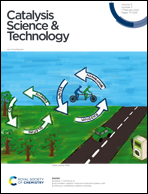A simple and highly efficient composite based on g-C3N4 for super rapid removal of multiple organic dyes from water under sunlight†
Abstract
A simple and highly efficient porous composite via a solvent evaporation method using g-C3N4 and NiSO4 was developed. It can super rapidly remove multiple organic dyes from water including rhodamine B (RhB), indigo carmine (IC), methylene blue (MB) and Congo red (CR) at room temperature and under sunlight. The optimal composite 50%NiCN was obtained by an orthogonal experiment, and it exhibited high removal ability towards the above four organic dyes up to 99.9% within 1 minute, even 96.9% in 2 seconds. The good stability of such a composite has been confirmed after five cycles and its possible degradation pathway was discussed. The dynamics of the photocatalytic degradation reaction were explored based on the structure of the organic dyes and the morphology of the photocatalyst by DFT calculations. In addition, simulation of the interactions between sunlight and the composite was performed by the field-only surface integral method. These two theoretical studies supply the reasonable explanation for this photocatalytic function in depth.



 Please wait while we load your content...
Please wait while we load your content...